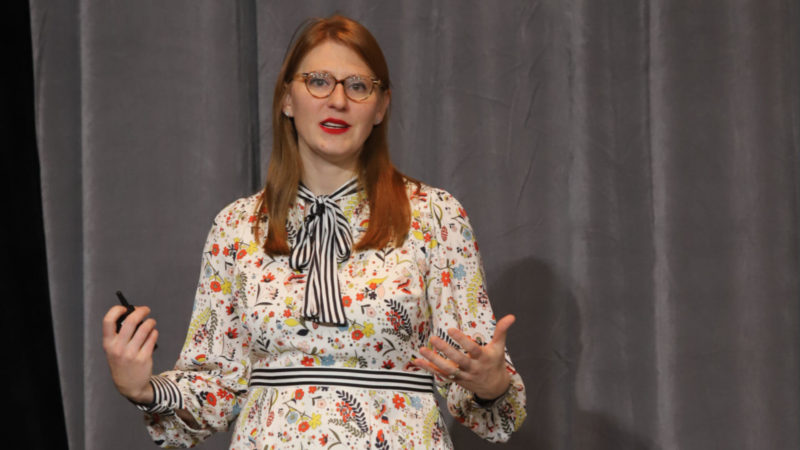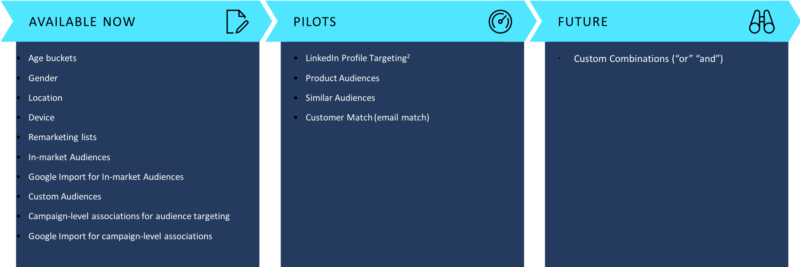Microsoft Advertising talks intelligence, UI updates, audience solutions in SMX keynote
Customer journeys are getting more complex and less linear, which means it's more imperative than ever for advertisers to understand the advanced technologies and innovations that drive meaningful brand engagement.

NEW YORK – As brands look to compete in today’s market, identifying ways to connect with audiences is critical. Growth relies heavily on the marketer’s ability to find better ways to meet the needs of customers, said Christi Olson, head of evangelism at Microsoft Advertising and Bing, during a keynote session at SMX West on Wednesday.
“Consumers want brands to help them, anticipating their needs and making their buying experience frictionless,” Olson said. “Our [Microsoft’s] goal is to help retailers become more competitive and deliver more engaging customer experiences that unlock new revenue and fuel future growth,” she added.
The growing complexity of the consumer’s digital footprint means advertisers need to understand the advanced technologies and innovations that drive meaningful brand engagement.
Delivering value with AI
According to Olson, Microsoft Advertising is gearing up to build better experiences for customers using artificial intelligence and machine learning. One example, an app called Seeing AI, has helped more than one million people with vision impairments complete tasks like reading a menu in restaurant or counting money to make a purchase.
Microsoft AI has added value to organizations as well, Olson explained, such as helping to quickly identify and resolve equipment issues remotely, or helping HR teams to recruit top candidates.
In terms of the future, it’s evident that Microsoft has set out to build more advanced solutions that can connect the customer journey through intelligent learning.
(See Also: Get the just-released Periodic Tables of PPC)
“Creating better experiences for your customers, people you engage with is not about handing off your advertising to machines. At a time of advancing automation, creativity remains the essential differentiator of greater value than at any other point in human history,” Olson said.
To help organizations adopt AI-driven capabilities quickly and easily, Microsoft is working to bring intelligence to the products and services consumers already use daily. Olson said that Microsoft will be launching a new class of purpose-built Dynamics 365 AI solutions aimed at delivering out-of-the-box insights from unified data. That data can then be infused with advanced intelligence to support integrated actions across sales, customer service, and marketing teams.
Personalization at scale
User devices provide context. And context helps marketers better understand what matters to a consumer in a particular location and at a particular time. The right message at the right moment is the next level in customer service and can turn intent into action.
Context also allows retail businesses to more accurately anticipate what a customer might need, based on when, where, and how they arrive on a brand’s website. Consumers are always hunting for product information, deals, local availability, and local discounts online, Olson explained. Retailers who don’t make efforts to supply the right, personalized information at the right time will lose out.
“As we think about this enormous opportunity, we at Microsoft see four key areas of opportunity for retail,” she said. These include:
Know your customer. Deliver unforgettable customer experiences that make your brand stand out from the crowd.
Empower your employees. Provide your team with the tools that enable extraordinary customer service.
Deliver intelligent supply chain. Improve agility to reduce costs and drive customer satisfaction.
Reimagine your business. Stand out in today’s competitive retail environment by reinventing your business model, starting with the customers and working backward.
Uniting the Internet and the Intranet
One of the biggest challenges facing internal organizations is the inability to quickly and accurately locate company information through intranet networks. Earlier this month, Microsoft introduced the new Microsoft Edge and Microsoft Bing for business.
Olson said Microsoft’s ambition is for Bing and Edge to deliver the best search and browser experiences for businesses and consumers alike. With enhanced capabilities like deep intranet integration, improved people search, and features that support internal resources, Microsoft is setting out to help employees be more efficient and productive.
Olson said Microsoft will be introducing more features for the consumer audience in spring 2020.
Microsoft’s redesigned UI
In October, Microsoft Advertising unveiled the platform’s interface refresh, designed to better align with the update Google Ads rolled out in full a year ago.
The redesigned UI, explained Olson, enables advertisers to manage campaigns more easily with the following improvements:
Improved usability and navigation. The new online navigation includes more intuitive features for greater integration with Google Ads, saving advertisers more time when it comes to campaign management. Advertisers can use the new global menu to switch accounts, quickly access tools and settings like ad preview, shared library, conversion tracking, Google Import, and more.
Better organization of features. The new vertical page menu includes Ads & Extensions, Audiences, Experiments, and other features to deliver more streamlined access for advertisers. As advertisers navigate campaigns, page menus will adapt to only display the pages and data that are applicable to each campaign.
Modern look and feel. The new online experience is now more up to date and consistent with other Microsoft products.
Intelligent audience solutions
Currently, Microsoft Advertising offers intelligent audience solutions designed to help advertisers reach a target audience with a personalized ad experience at the right time.
These solutions include AI-driven targeting capabilities such as location, device, in-market audiences, Google Import, campaign-level associations, and more. Microsoft is currently piloting LinkedIn Profile Targeting, product audiences, similar audiences, and customer matches.
Eventually, Olson said, Microsoft plans to roll out customer combinations with “or” and “and” logic.

Amping up for new retail solutions
“For retailers to power great experiences on their website, search is critical,” Olson said.
With Intelligent Search, Microsoft aims to bring advertisers closer to understanding shopper intent with scale, intelligence, and AI. To do this, Olson pointed to Bing’s index that retailers can embed on their sites to grow visibility. Bing technology can help marketers understand consumer behavior and trends while leveraging machine learning and AI to help automatically optimize conversion actions.
Intelligent Search, part of Microsoft’s vision to offer more search solutions to retailers, will deliver personalized product recommendations using deep learning algorithms. Experimentation and custom rankings will help businesses achieve goals and drive up consumer satisfaction. Additionally, advertisers will have an improved ability to analyze transactional, behavioral, and demographic data from the sites.
As part of this broader focus on retail, in August, Microsoft acquired PromoteIQ, a vendor marketing solution that enables retailers to serve product ads across retailer websites.
The age of digital marketing is behind us, and our new reality—though it may at times seem daunting—is marketing in the digital age, Olson said. One in which marketers simply cannot find success talking at customers through single, traditional channels. Instead, brands must engage with them on new and meaningful levels, wherever they are.
As Olson stated during her session, Microsoft is setting out “to help reimagine how [advertisers] serve customers and grow your business, deliver more engaging customer experiences that unlock new revenue and fuel future growth.”
Contributing authors are invited to create content for Search Engine Land and are chosen for their expertise and contribution to the search community. Our contributors work under the oversight of the editorial staff and contributions are checked for quality and relevance to our readers. Search Engine Land is owned by Semrush. Contributor was not asked to make any direct or indirect mentions of Semrush. The opinions they express are their own.


